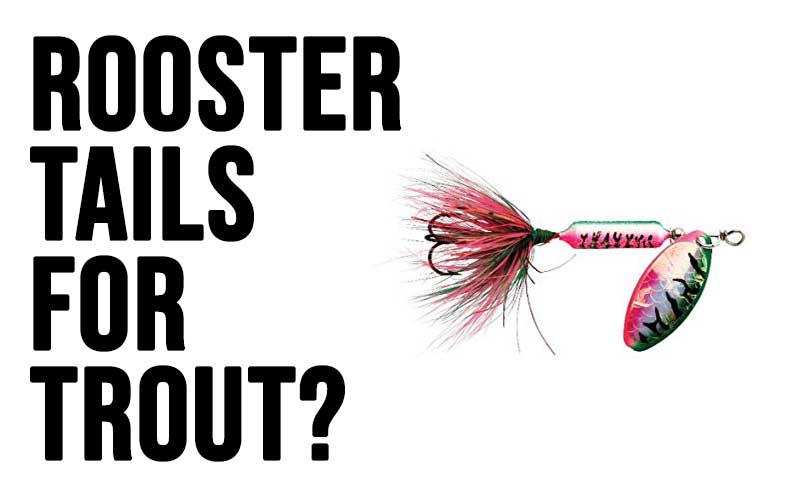The Rooster Tail is one of the most iconic spinning lures of all time. Originally developed by Howard Worden in the 1950s, the lure features an elongated blade, painted body, and hackle-dressed treble. Rooster Tails of various sizes can be excellent lures for many different species, however, the question remains:
Are Rooster Tails a Good Trout Lure? The answer is most definitely. They are offered in various colors and sizes for every different water condition. The narrow style blade tends to spin better in moving water compared to other blade styles. The hackle-dressed treble also moves in an enticing, pulsating action when being retrieved through the water. All of these features combined make the Rooster Tail an exceptional choice for targeting Trout of various species.
In the post below, I’m going to break down in depth exactly why the above-listed benefits will help you catch more Trout. It’s easy to overlook the finite details that make the Rooster Tail special considering how simplistic a spinner bait is.
What Rooster Tail Pattern is Best for Trout?
It’s very hard (nearly impossible) to select one pattern that is best for trout. That being said, it’s entirely possible to select a few proven patterns that consistently put fish in the net.
The best Rooster Tail Patterns for Trout are those that imitate trout’s natural forage. Select baits that contain Gold or Silver Blades, with black or yellow bodies. Another excellent pattern is using a bait painted in a trout pattern.
The flashy gold and silver blades produce a ton of vibration that the fish can feel using their lateral line. They also look like the flash from a passing baitfish’s scales.
Another excellent option to consider is using a treble hook dressed with some form of hackle or feather. My personal favorite dressing colors are black and red. If I had to choose one it would be red.
It might be superstition, but I find that the red hook leads to an increase in hookups. I believe the red dressing on a hook gives the fish an aim point that it can swipe at when attempting to grab your lure.
If I had to pick just 5 Rooster Tail pattern’s to go fishing with for trout, these are it:
1: Rusty Crawdad
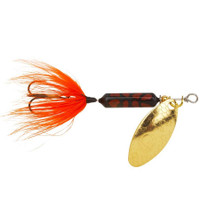
This pattern hits all three of my favorite checkboxes: Gold Blade, Black Body, and Red Dressed Treble. This is a lure I would often start out fishing to try and determine feeding habits and trout locations when entering the stream.
2: Brown Trout
The vast majority of my time spent trout fishing is spent fishing for Brown Trout. This spinner would surely see a lot of line time if it were in my tackle box out on the stream.
3: Gold Flame Tiger
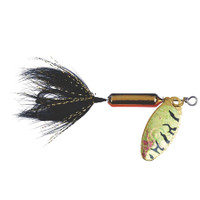
I am a big fan of this lure. One of my favorite times to fish for trout is when the water is murky. They feel more safe coming out from under cover and if you time it just right, you can get into a feeding frenzy. When fishing in dirty water, I like to use a lure with a lot of flash, but also a dark profile that stands out. This lure is excellent, a big black tail, and highly reflective blade, body, and extra flashy gold strands tied to the treble.
4: Black
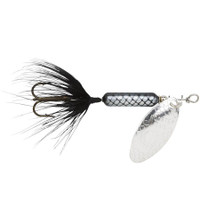
Although I usually fish with gold blades (just a confidence thing), sometimes the trout are really keyed in on Silver. This lure has a good dark profile and has a very reflective silver blade that represents a passing baitfish.
5: Skunk
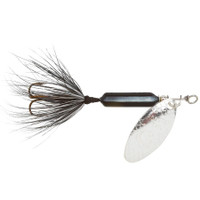
This is another good alternative for those Silver blade days. I really like the solid blackish body on this lure, and the tail has a bit of white in it which makes for a lighter profile. Sometimes the lighter lure’s just fish better, so it’s important to keep a few in your tackle box.
Best Rooster Tail Sizes for Trout
Choosing the right weight rooster tail is going to be very important for your outing on the trout stream. There are several factors to consider when choosing a size weight to fish with.
- Water Depth: In rivers and streams, trout lay on the bottom, they do not suspend in the water column. They face upstream waiting for an opportunity to dart out and grab a quick meal. You want to choose a weight that can get down towards the bottom and present itself in front of the trout, rather than too far above them.
- Water Speed: The speed of the current can keep your lure higher up in the water column, so in faster water, I typically fish with a little heavier lure than in normal circumstances. This ensures the lure will sink quicker and get down towards where the trout are lurking.
- Size of the Water: This is important for two reasons. The first is a heavier lure can cast farther, and you can maximize your odds of catching fish by presenting your spinner across more water. The second reason is that tiny little streams typically hold smaller fish.
- Although I have caught really small fish on very large lures, and similarly very big fish on small lures, a good rule of thumb is to match your presentation to the size of the trout in the stream. This will optimize your fishing experience by tailoring the size of the spinner to the food the trout are most likely eating.
For smaller streams, I like to throw 1/16oz. and 1/4oz lures most of the time. If I get to an are where the water looks really good and I feel a bigger fish might be lurking, I will change my lure out to a slightly bigger size.
The 1/6oz. and 1/8oz. are the sizes I spend the most time fishing. I find with a good long rod, I can control these lures in almost any water situation. They are also a great size for catching trout of all sizes.
For larger rivers or lakes, I will throw the larger 3/8oz. size. This is a fairly big spinner and produces a lot of flash and vibration. This is also my go-to size when fishing in stocked trout lakes or ponds.
They do make a 1/2oz, 3/4oz, and 1oz size as well, but I find they are typically a bit big for the trout water I am fishing in. For steelhead or salmon, they might make for a great option.
Rooster Tail Design
The design of the Rooster Tail is very similar to other spinnerbait styles. The bait is built on a thin wire shaft. The narrow blade is attached via a small metal clevis. Below that, a small bead is placed.
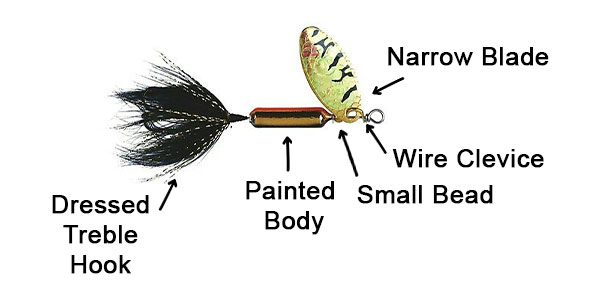
The beat acts as a bearing for the Clevis and allows the blade to rotate freely. Next, a painted lure body is placed on the wire shaft. Finally, a dressed treble hook is added to the end of the lure. Oftentimes the blade, body, and treble are assembled to match a specific color pattern.
Most trout fishermen target trout in rivers and creeks due to the colder water and increased oxygen that Trout require to live and reproduce. The narrow blade on the Rooster Tail means that your bait will spin or “work” better in moving current. The blade spins closer to the body at a smaller angle, which means you can count on the blade spinning all the way through your retrieve.
Why Rooster Tails Catch Trout
It’s important that your blade continues to spin as you pull it all the way through the water. The flash that comes off the blade is a major attraction factor. Another reason is that the blade sends vibrations through the water that trout can sense and can help trigger their predatory instinct.
Sometimes when you pull a French or Indiana blade bait through fast current, the blade will stop spinning from the current knocking it out of the rotation.
The painted lure body is unique compared to other spinner baits for trout. The combination of individual blade, body and hackle colors means you can really fine tune in on a color combination that works best in your area.
The lure body on a Rooster Tail gives the bait a larger overall profile and provides an excellent area for predatory trout to swipe at.
The Rooster Tail also comes with a dressed hackle treble. This dressed treble can provide extra flash/movement in the water that can act like the “finishing touch” to a suspicious trout. I also believe that having a dressed treble can give the trout something to aim at when they strike at your lure.
Oftentimes, your lure will get “bumped” when a fish swings and misses in an attempt to eat your lure. I find that having a dressed treble helps with hookup ratios, and can lead to a more successful day on the water.
